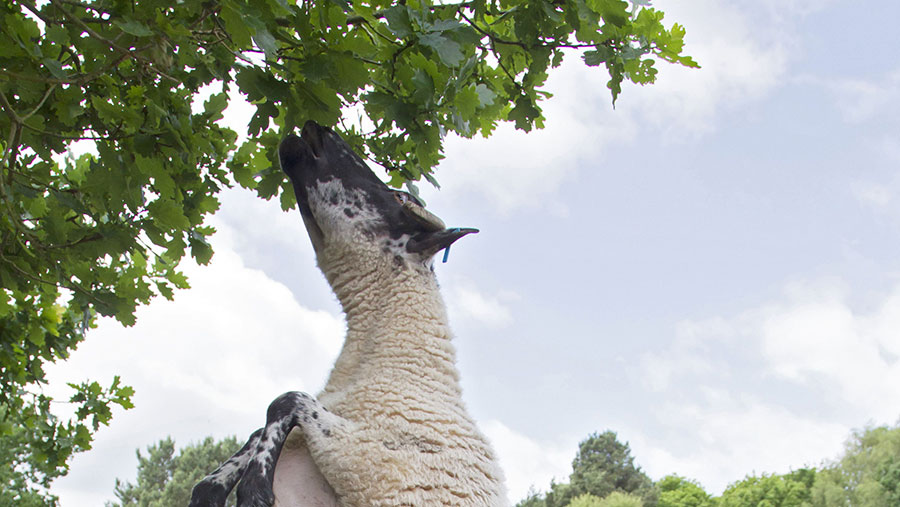ORFC 2020: Tree leaves could counter zinc and cobalt deficiencies in livestock
 © FLPA/Shutterstock
© FLPA/Shutterstock Researchers have found willow trees could play an important role in combating mineral deficiencies in livestock.
The research, carried out for the Woodland Trust, showed willow could act as a valuable cobalt and zinc supplement.
The study looked at how trees in shelter-belts, hedgerows and in-field locations could provide additional tree-browse and fodder.
See also: How to reduce the risk of abortions in cattle
Mineral levels in various native woodland species – including willow, alder and oak – were investigated. While selenium levels were dependent on the site itself, cobalt and zinc were significantly higher, particularly in willow trees.
Zinc
Oak provided roughly 25mg/kg dry matter (DM) of zinc when trees were sampled in June. Alder leaves contained about 50mg/kg DM in June, but willow samples had levels more than three times as high at 175mg/kg DM.
A second sampling period in September showed zinc levels had increased to 200mg/kg DM in the willow trees, while the alder and oak had reduced slightly.
Cobalt
Cobalt levels showed an even greater proportional difference across the species, with willow yielding about 2.5mg/kg DM in June and 3.5mg/kg DM in September. Alder and oak contained about 0.1-0.2mg/kg DM across the two periods.
The Woodland Trust suggested that at these levels, the mineral concentrations could help to correct deficiencies in grazing animals.
Nigel Kendall of the University of Nottingham, one of the research centres involved in the trials, explained: “There are 22 essential minerals relevant to ruminant nutrition, and some of these are prone to imbalances, either providing too much, too little, or interacting with other elements.
“The minerals likely to cause issues in grazing ruminants are imbalances in trace elements such as cobalt, selenium, iodine, copper and zinc.”
Dr Kendall added the analysis had found tree leaves could be considered a good source of a number of those key minerals within the requirement range for sheep, and potentially offered similar or better concentrations than a sward.
“The elevated cobalt and zinc concentrations in willow leaves could actively correct deficiencies of these minerals in grass that usually require supplementation,” Dr Kendall said.
“This could be especially useful in growing grazing lambs where cobalt deficiency typically prevails across the dry summer periods.
“Lambs tend to perform well in the spring because they are still getting the ewe’s milk, but as they take less and enter the dry summer period, there is an issue because the cobalt levels in grass begin to deteriorate.”
He said this meant growth could slow or stop all together.
“But by providing access to willow leaves, farmers can remedy that. By opening a gate into a paddock with trees, or allowing access to a living fence, livestock can get a biological supplement in the form of fodder that will benefit growth rate.”
Launching the research findings at the Oxford Real Farming Conference on 8 January, the Woodland Trust’s senior farming adviser, Helen Chesshire, said: “Trees on farms provide animals with a number of benefits such as shelter and shade, as well as supplementing their diets with tree browse or fodder.
“This research adds another compelling reason, recognising the nutritional composition of tree browse and fodder and the supplementary potential for livestock.”
Ms Chesshire said: “Ultimately, it will help farmers to implement tree-based solutions to enhance livestock performance and health while also delivering benefits to the wider environment.”
Researchers are now engaged in follow-up work. A further trial into the palatability of willow and its use as a supplement has been undertaken by the University of Nottingham and the Leicestershire-based Allerton Project.
It will look at how many trees and what type of planting would be required to support a ruminant diet and what effect the varying content of anti-herbivorous compounds such as tannins can have on medicinal value.
The initial research was led by the Woodland Trust, together with the University of Nottingham, the Organic Research Centre, University of Reading, Bangor University and the Game and Wildlife Conservation Trust.
